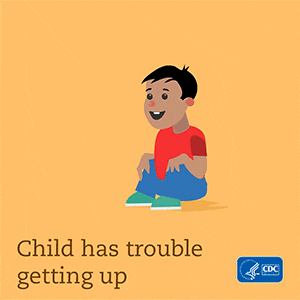Families Continue to Experience Delay in Getting a Diagnosis of Duchenne Muscular Dystrophy

Early screening, identification, and diagnosis of muscular dystrophies enable children and families to get the services and support they need as soon as possible.
- In a study using updated data from CDC’s Muscular Dystrophy Surveillance, Tracking, and Research Network (MD STARnet), researchers found that it takes 2.3 years longer for families of non-Hispanic Black males than both non-Hispanic White and Hispanic males to receive their initial evaluation for Duchenne muscular dystrophy (DMD). Delays for the first evaluation and confirmatory diagnosis of muscular dystrophies prevent children and families from getting the services and support they need as soon as possible.1
- Read a summary of the scientific findings.
- In a study using updated data from CDC’s Muscular Dystrophy Surveillance, Tracking, and Research Network (MD STARnet), researchers found that it takes 2.2 years for families without a family history of DMD to receive a diagnosis of DMD. Early screening, identification, and diagnosis of muscular dystrophies enable children and families to get the services and support they need as soon as possible.2
- Read a summary of the scientific findings.
About MD STARnet
CDC’s MD STARnet collects critical information about muscular dystrophies for researchers to use to improve care for those living with the disease. MD STARnet collects information from medical clinics, as well as other sources, including hospitals and birth and death certificates.
About Muscular Dystrophies
Muscular dystrophies are a group of genetic disorders that result in muscle weakness over time. Each type of muscular dystrophy is different from the others. It is important to get diagnosed as early as possible. Muscular dystrophy has no cure, but an earlier diagnosis may help an individual with muscular dystrophy get earlier access to the services and treatments they need to lead a full life.

Parents: Use this tool to help address concerns about your child’s physical development.
In collaboration with the American Academy of Pediatrics, CDC has developed a web-based tool for parents who are concerned about the physical development of their child. Parents can identify “red flags” they see when their child stands, walks, climbs stairs, holds toys, and does other activities.
Our Work
Although much has been accomplished, important research questions remain to ensure people living with muscular dystrophies reach their full potential. CDC’s National Center on Birth Defects and Developmental Disabilities (NCBDDD) is working to estimate the number of people with each major kind of muscular dystrophy in the United States. This will enable a better understanding of how common muscular dystrophies are, the potential benefit of certain medicines and therapies, and the mental health of people living with muscular dystrophies. NCBDDD is also working to improve the health and quality of life for individuals with muscular dystrophies by partnering with healthcare professionals, university researchers, patient organizations, and state health departments to help clinicians provide the best possible care to people with DMD and enhance early screening, identification, and diagnosis of muscular dystrophies.
Resources for Parents
As a parent, you know your child best. If your child is not meeting the milestones for their age, or if you think there could be a problem with the way your child plays, learns, speaks, acts, or moves, talk to your child’s doctor and share your concerns. Early screening, identification, and diagnosis of muscular dystrophies enable children and families to get the services and support they need as soon as possible.
More Information
- Muscular Dystrophy Diagnostic Tools
- Learn the Signs. Act Early.
- Duchenne Muscular Dystrophy Care Considerations
- Living with Muscular Dystrophy
References
- Joshua R. Mann, Yanan Zhang, Suzanne McDermott, Yinding Wang, Bo Cai, Kristin M. Conway, Pangaja Paramsothy, Julie Royer, Swamy Venkatesh, James F. Howard Jr., Emma Ciafaloni, The MD STARnet; Racial and Ethnic Differences in Timing of Diagnosis and Clinical Services Received in Duchenne Muscular Dystrophy. Neuroepidemiology2 May 2023; 57 (2): 90–99. https://doi.org/10.1159/000528962
- Thomas S, Conway KM, Fapo O, Street N, Mathews KD, Mann J, Romitti PA, Soim A, Westfield C, Fox DJ, Ciafaloni E, Muscular Dystrophy Surveillance, Tracking, and Research Network (MD STARnet). Time to Diagnosis of Duchenne Muscular Dystrophy Remains Unchanged: Findings from the Muscular Dystrophy Surveillance, Tracking, and Research Network, 2000-2015. Muscle & Nerve. 2022. [epub ahead of print]